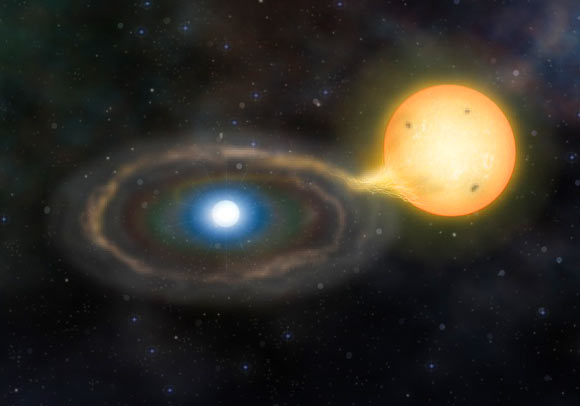Using ESA’s Gaia satellite, a large multinational group of astronomers has discovered a unique binary star system: the first known such binary where one star completely eclipses the other.

This is an artist’s impression of the unique binary system Gaia14aae. Image credit: Marisa Grove / University of Cambridge’s Institute of Astronomy.
The binary system, dubbed Gaia 14aae, lies in the constellation Draco, approximately 730 light-years away.
It is a type of two-star system known as a ‘cataclysmic variable,’ where one super dense white dwarf is stealing gas from its companion star, effectively ‘cannibalizing’ it.
It was first spotted by the Gaia satellite in August 2014 when it suddenly became 5 times brighter over the course of a single day.
The astronomers, led by Dr Heather Campbell from the University of Cambridge’s Institute of Astronomy, analyzed data from Gaia and determined that the sudden outburst was due to the fact that the white dwarf is devouring its larger companion.
Additional observations of the system found that Gaia 14aae is a rare eclipsing binary, where one star passes directly in front of the other, completely blocking it out when viewed from Earth. The two stars are tightly orbiting each other, so a total eclipse occurs roughly every 50 minutes.
Dr Campbell’s team also found that the system contains large amounts of helium, but no hydrogen, which is highly unusual as hydrogen is the most common element in the Universe.
The lack of hydrogen allowed the astronomers to classify Gaia 14aae as a very rare type of system known as an AM Canum Venaticorum (AM CVn), a type of cataclysmic variable where both stars have lost all of their hydrogen.
Gaia14aae is the first known AM CVn system where one star totally eclipses the other.
“It’s really cool that the first time that one of these systems was discovered to have one star completely eclipsing the other, that it was amateur astronomers who made the discovery and alerted us. This really highlights the vital contribution that amateur astronomers make to cutting edge scientific research,” said Dr Campbell, who is the first author of a paper published in the journal Monthly Notices of the Royal Astronomical Society (arXiv.org preprint).
AM CVn systems consist of a small and hot white dwarf star which is devouring its larger companion. The gravitational effects from the hot and superdense white dwarf are so strong that it has forced the companion star to swell up like a massive balloon and move towards it.
The companion star in Gaia 14aae is about 125 times the volume of our Sun, and towers over the tiny white dwarf, which is about the size of the Earth. However, the companion star is lightweight, weighing in at only 1% of the white dwarf’s mass.
AM CVn systems are prized by scientists, as they could hold the key to one of the greatest mysteries in modern astrophysics: what causes Type Ia supernova explosions? This type of supernova, which occurs in binary systems, is important in astrophysics as their extreme brightness makes them an important tool to measure the expansion of the Universe.
In the case of Gaia 14aae, it’s not known whether the two stars will collide and cause a supernova explosion, or whether the white dwarf will completely devour its companion first.
_____
H. C. Campbell et al. 2015. Total eclipse of the heart: the AM CVn Gaia14aae/ASSASN-14cn. MNRAS 452 (1): 1060-1067; doi: 10.1093/mnras/stv1224







